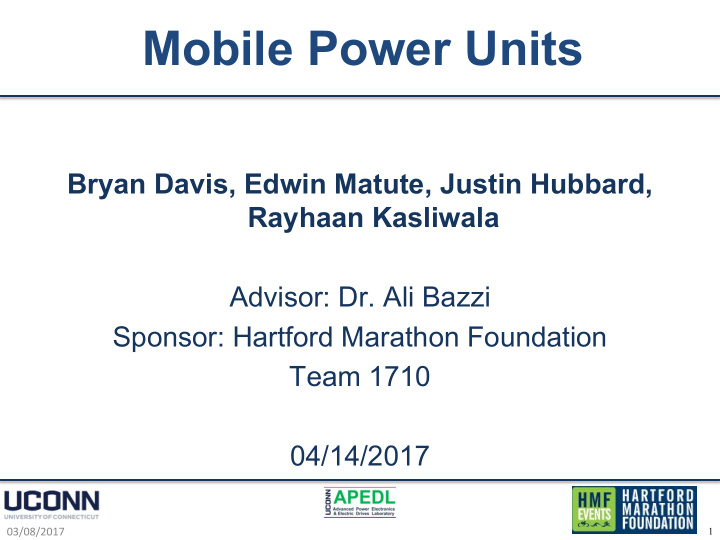



Mobile Power Units Bryan Davis, Edwin Matute, Justin Hubbard, Rayhaan Kasliwala Advisor: Dr. Ali Bazzi Sponsor: Hartford Marathon Foundation Team 1710 04/14/2017 1
Outline 1. Team Objectives 2. Summary of Major Equipment a. Solar Panel b. Battery c. Inverter d. Charge Controller e. Auxiliary 3. Panel Mounting 4. Installation 5. Data & Results 2
Team Objectives 3
Team Objectives ❖ Electrical Loads Sustain all critical loads. ➢ ❖ Weight and Structural Durability Trailer weight and safety. ➢ Limited roof space. ➢ ❖ HMF Event Dates Compensate for back to back events. ➢ ❖ Budget Concerns ~$5000 ➢ 4
Overall System Diagram Battery Bank 5
Summary of Equipment Batteries: Outback 200NC, 12V, 178AH, Lead-Deepcycle (x3 - in parallel) 24/48V Batteries are not cost effective (>$1000) and ❖ AH rating is more than needed. 178AH batteries to increase reliability of system. If 1 ❖ battery malfunctions, system still functionable. Solar Panels: Astronergy 315 Watt Silver Poly Solar Panel ❖ The $224 per panel with a 315 watt power output was optimal for our load requirements and budget ( $0.71 per watt ). $4 more than cheapest option, while producing 55 ❖ watts more . 6
Summary of Equipment Inverter: Samlex PST-1500 Max 1500W, 12.5A output ❖ Handles our 9.18A load current ➢ ➢ Can handle motor inrush current Built-in GFCI protection ❖ Charge Controller: Midnite Classic 150 MPPT, Output : 80 - 96A ❖ Supports our 12V battery voltage ➢ ➢ Remote control and display via computer Built-in ground fault and arc detection ❖ 7
Summary of Equipment Midnite Whiz Bang Jr. (with Shunt) Measures net current in and ❖ out of batteries to provide state of charge Fuses: 15, 100, and 110A for ❖ additional protection 15A 100A 110A 8
Panel Positioning HMF was concerned about ❖ mounting of panels, structural integrity of roof, and weather Mounting vertically enabled each ❖ panel to be mounted to 4 different structural beams at a total of 8 points each. Aluminum brackets used ❖ to resist corrosion 9
Panel Mounting Panels need to be mounted ❖ securely for freeway travel without vibration. HMF should be able to remove with ❖ ease. Roof should remain waterproof ❖ even after panels removed. HMF’s concern for trapped water. ❖ 10
Panel Mounting 11
Charge Controller Installation 100A fuse in between the charge controller Whiz Bang Jr. and batteries Mounted in visible area ● Battery temp sensor ● PV in wires (14 AWG) Battery out wire (4 AWG) ● ● Chassis ground wire with quick disconnect (8 AWG) before 100A fuse 12
Inverter Installation • Chassis ground (8 AWG) • Input wire from battery (1/0 AWG) connected to quick disconnect • SJOOW cord that leads to receptacles 13
Battery Installation • Batteries were connected in parallel with 1/0 AWG • Wooden battery frame for fixed positioning • 110A fuse between the batteries and inverter. 14
Receptacle Box Installation • SJOOW fed to junction box with conduit containing 14 AWG wires coming out • Conduit runs through bottom of trailer and to exterior weatherproof receptacle box 15
Results 16
Results 17
Data Acquisition We are focusing on four questions to gather data: 1) With no PV input, how long can we run stated loads before batteries reach 20% SOC? 2) With batteries at 20% SOC, how long does it take to get them back up to 100%? 3) With all identified loads running, what is the inverter AC output (rms current, voltage, PF, etc.) and the DC input current? 4) What is the motor start-up transient AC current and PF, and DC current. 18
Data Acquisition ❖ Using the Charge Controller built in function to gather data on the DC side of system. ❖ AEMC 8220 Power Meter will be used to gather data on the AC side. 19
Motor Inrush Data 20
Motor Inrush Data All values within specifications ★ of equipment Higher DC power supplied due ★ to slight inefficiency of inverter Average data from 10 trials: AC DC Starting Steady-State Starting Steady-State Current (A) 6.845 2.720 107.4 29.2 PF .7959 .8843 -- -- 21
Data - All Loads Powering motor blower, 3 speakers, 1 wifi router, 2 laptop chargers (721W nameplate total) Motor turn-on Max (+1) Volume Speakers and 500Hz +2 Volume +2 Volume laptops tone plugged in applied +2 Volume -3 Volume Higher than nameplate 110W 22
Panel Performance To date: (76% nameplate) ● Occurred on April 8, irradiance ~89% of yearly max ● Panels able to power entire DJ setup while charging batteries to 100% 23
Budget Summary Component Cost Panels $698 Batteries $1,235 Inverters $429 Charge Controller $611 Electrical Equipment $298 Mechanical Equipment $79 Shipping $358 Total $3,708 24
Conclusion ❖ HMF is exceedingly pleased with their new system. Have used it at all 5 races they’ve had since the start of this year without any issues. “The system has been working fantastically. Exceeding my expectations.” - Matt Anderson, Director of Operations 25
Thank You! Any Questions? 26
Recommend
More recommend